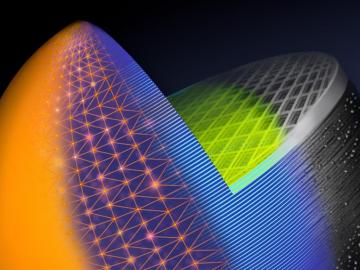
Filter News
Area of Research
- Advanced Manufacturing (10)
- Biology and Environment (48)
- Biology and Soft Matter (1)
- Clean Energy (119)
- Climate and Environmental Systems (1)
- Computer Science (3)
- Electricity and Smart Grid (1)
- Energy Frontier Research Centers (1)
- Fusion and Fission (10)
- Fusion Energy (1)
- Isotopes (1)
- Materials (99)
- Materials for Computing (10)
- National Security (15)
- Neutron Science (29)
- Nuclear Science and Technology (10)
- Quantum information Science (5)
- Supercomputing (57)
News Type
News Topics
- (-) 3-D Printing/Advanced Manufacturing (82)
- (-) Advanced Reactors (18)
- (-) Climate Change (71)
- (-) Energy Storage (70)
- (-) Grid (38)
- (-) Nanotechnology (42)
- (-) Physics (52)
- (-) Quantum Science (56)
- (-) Transformational Challenge Reactor (7)
- Artificial Intelligence (75)
- Big Data (31)
- Bioenergy (74)
- Biology (80)
- Biomedical (45)
- Biotechnology (18)
- Buildings (31)
- Chemical Sciences (52)
- Clean Water (15)
- Composites (15)
- Computer Science (140)
- Coronavirus (34)
- Critical Materials (13)
- Cybersecurity (31)
- Decarbonization (64)
- Education (4)
- Element Discovery (1)
- Emergency (2)
- Environment (138)
- Exascale Computing (34)
- Fossil Energy (5)
- Frontier (38)
- Fusion (44)
- High-Performance Computing (70)
- Hydropower (5)
- Isotopes (45)
- ITER (4)
- Machine Learning (35)
- Materials (100)
- Materials Science (94)
- Mathematics (6)
- Mercury (9)
- Microelectronics (3)
- Microscopy (36)
- Molten Salt (3)
- National Security (54)
- Net Zero (11)
- Neutron Science (96)
- Nuclear Energy (81)
- Partnerships (43)
- Polymers (20)
- Quantum Computing (29)
- Renewable Energy (2)
- Security (22)
- Simulation (39)
- Software (1)
- Space Exploration (15)
- Statistics (2)
- Summit (50)
- Sustainable Energy (74)
- Transportation (52)
Media Contacts

In the wet, muddy places where America’s rivers and lands meet the sea, scientists from the Department of Energy’s Oak Ridge National Laboratory are unearthing clues to better understand how these vital landscapes are evolving under climate change.

Participants in the SM2ART Research Experience for Undergraduates program got the chance to see what life is like in a research setting. REU participant Brianna Greer studied banana fibers as a reinforcing material in making lightweight parts for cars and bicycles.

ORNL's Guang Yang and Andrew Westover have been selected to join the first cohort of DOE’s Advanced Research Projects Agency-Energy Inspiring Generations of New Innovators to Impact Technologies in Energy 2024 program. The program supports early career scientists and engineers in their work to convert disruptive ideas into impactful energy technologies.

Advanced materials research to enable energy-efficient, cost-competitive and environmentally friendly technologies for the United States and Japan is the goal of a memorandum of understanding, or MOU, between the Department of Energy’s Oak Ridge National Laboratory and Japan’s National Institute of Materials Science.

Researchers at ORNL have developed the first additive manufacturing slicing computer application to simultaneously speed and simplify digital conversion of accurate, large-format three-dimensional parts in a factory production setting.

Researchers used quantum simulations to obtain new insights into the nature of neutrinos — the mysterious subatomic particles that abound throughout the universe — and their role in the deaths of massive stars.

In May, the Department of Energy’s Oak Ridge and Brookhaven national laboratories co-hosted the 15th annual International Particle Accelerator Conference, or IPAC, at the Music City Center in Nashville, Tennessee.
Close on the heels of its fourth summer school, the Quantum Science Center, or QSC, hosted its second in-person all-hands meeting in early May. More than 150 scientists, engineers and support staff traveled from 17 institutions to review the QSC’s progress, examine existing priorities and brainstorm new short- and long-term research endeavors.

When Oak Ridge National Laboratory's science mission takes staff off-campus, the lab’s safety principles follow. That’s true even in the high mountain passes of Washington and Oregon, where ORNL scientists are tracking a tree species — and where wildfires have become more frequent and widespread.

Purdue University hosted more than 100 attendees at the fourth annual Quantum Science Center summer school. Students and early-career members of the QSC —headquartered at ORNL — participated in lectures, hands-on workshops, poster sessions and panel discussions alongside colleagues from other DOE National Quantum Information Science Research Centers.


